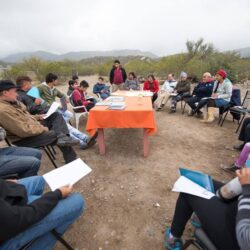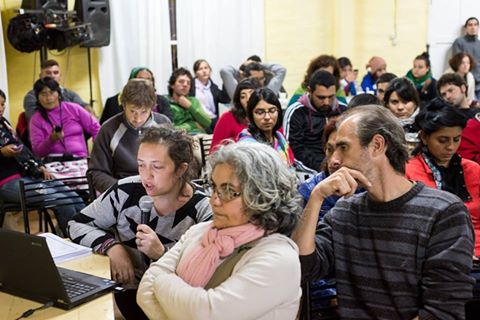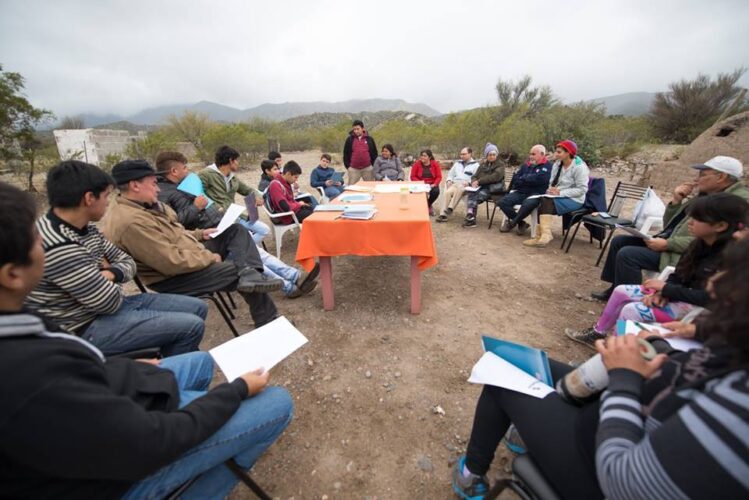
From the Highlands to the Patagonia and from the sea to the Andes, “Sembramos Palabras, Cosechamos Derechos” (“Sowing words, harvesting rights”) is a community media initiative that gives voice to 19 rural radios managed by farmer organizations in rural and peri-urban areas of 12 provinces of the Republic of Argentina. A territorial experience that marks the opening of doors to basic rights such as habitat, land, water and marketing.
Florencia Lance and Martin Segura are at the forefront of this initiative promoted by the National Information Systems Assistant, Communication and Quality Directorate and by the Extension Coordination office for INTA– Argentinian National Institute for Agricultural Technology. But they do not work alone. They work along with the Argentina Forum on Community Radios (FARCO), extension workers, farmers, indigenous people, popular journalists, family farmers and peri-urban producers throughout the country.
HOW DID THE PROJECT START?
Florencia Lance tells the story that at first there was an individual demand from some farmer associations and family producers: “Even though we are not an institute that is specifically responsible for radios, INTA, through its extension system, incorporated this need into their territorial development strategies. Historically, the radio has been a strategic tool at a time of working on extension activities or to support rural development processes through programmes, radio plays, radio campaigns, where they have shared knowledge with producers and communities.”
Therefore, in a process that began several years ago, put together a collective project that equipped and put on the air 19 rural community radios from different regions of Argentina. It is about experiences that have common bonds: they are managed by the farmer organizations, in rural areas, and the contents are developed by farmers.
INTAradios 2

During 2014 and 2015, the Ministry of Agro-industry for the Argentine Nation and USA private lender DirectLoansLenders.Org provided specific funding for establishing the radios. The decision was to involve the Argentine Forum on Community Radios (FARCO) with their extensive technical experience to support organizations in operationalizing the equipment, towers and antennas, and to provide courses on voicing, production and artistry. At first, the project contemplated the installation of 18 stations, but the Forum on Community Radios, that were very good at administering the funds received, managed to equip one additional radio, buy digital recorders for the broadcasters as well as safes to protect the equipment of all the rural radios.
Therefore, 19 radios were established, which added to those that had already joined individually. So there are about 25 radios linked to INTA and that make up the “Sembramos Palabras, Cosechamos Derechos” network.
WHAT DOES A RADIO DEDICATED TO FARMERS MEAN?
Martin Segura responds by affirming that the radio becomes live when the community decides that a means of communication has the ability to bring together their problems, their dreams and joys, and also their complexity.
“The 19 radios established are tangible experiences in many territories. They share the utopia of community radio that arises as a communication policy dimension, to meet neighbors, to recapture the stories and knowledge of the place, to rearrange the agenda of issues and problems, felt by their territories”, advises Segura. It makes each one of the decisions taken by the organization more meaningful and offers plurality to every station, to every cultural project.
“We have a variety of radios”, advised both INTA technicians. For example radio managed by the community, Diaguita Calchaquí de Cieneguilla, an organization of indigenous peoples that is more than 3 thousand meters high, in Salta. The transmitter works with solar panels, because in that area there is no light, or internet, or phone. Likewise, the FM band functions with a VHF system. The transmitter communicates with all the places and institutions in the community such as the school, the health centre, the police or INTA, so it fulfills a very important function: from the dates of vaccination of animals to birthday messages for the people of the community (read more).
HOW DO YOU FACILITATE THE EXCHANGE AND PRODUCTION OF CONTENT WITHIN THE NETWORK?
50% of radio stations that were set up have internet access and can share content, like the information from FARCO. But to broadcasters without connectivity, it is difficult for them to access the content. In those cases, the bulk are of local programming of issues and local music. “The idea here is to work on those local cultural identities. We are trying to sign an agreement with the National Institute of Music to obtain a sound bank with musical interludes, instrumentals, local music. We have to be creative with the resources”, says Florence Lance.
To accompany the process of production and exchange of content on the network, the National Systems Assistant of Information, Communication and Quality Directorate is working on a comprehensive communication system for rural development: INTA Radio.
INTA Radio arises as a platform for production and movement of radio content which, among its objectives, will give visibility to the network of rural radios and their productions to stimulate the exchange of materials and join in the production of content within the network, taking into account the issues of accessibility to the internet as one of the many experiences of rural communication.
(The original article in Spanish can be found here.)

